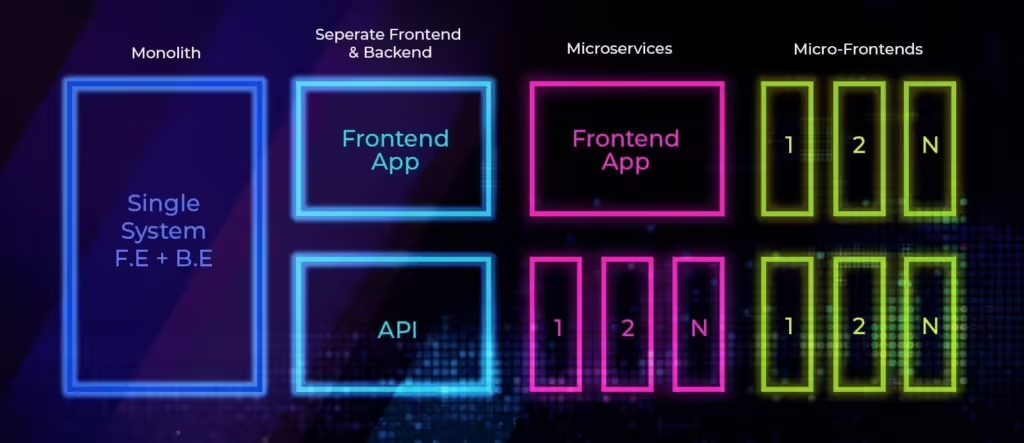In 2024, micro-frontends are becoming the go-to architecture for scalable and modular web development. As web applications grow in complexity, developers are adopting this approach to manage large projects more efficiently. By breaking a monolithic front-end into smaller, independent, and self-contained modules, micro-frontends allow teams to work on different parts of an application autonomously while ensuring seamless integration.
In this post, we’ll explore how micro-frontends have evolved in 2024, why they’re becoming a crucial tool for modern web development, and how you can leverage them to build scalable, resilient applications.
What Are Micro-Frontends?
Micro-frontends extend the concept of microservices to the front-end layer. Instead of having a monolithic user interface, the application is divided into smaller, manageable pieces—each one focused on a specific feature or function. These individual pieces can be developed, tested, and deployed independently, which accelerates development and improves scalability.

Key Advantages of Micro-Frontends
Micro-frontends bring a host of benefits, especially in large-scale projects where multiple teams or developers collaborate on different parts of an application. Here’s a closer look at why this approach is gaining traction:
1. Modularity and Reusability
Each micro-frontend is self-contained and can be reused across multiple applications. This modularity allows teams to share common components, reducing duplication of effort and improving development speed.
• Example: A company with multiple web apps can reuse the same login or payment module across all projects, ensuring consistency and saving time on development.
2. Independent Deployment
One of the key advantages of micro-frontends is that they allow for independent deployments. Unlike monolithic front-end architectures where a single bug could hold up an entire release, micro-frontends let you update and deploy individual parts of the application without affecting the rest.
• Example: If a checkout module requires an update, you can push that specific change live without redeploying the entire application.
3. Technology Agnostic
Each micro-frontend can be built using different frameworks or libraries. This means teams can choose the best tools for their specific module, ensuring optimal performance and flexibility.
• Example: While one team may use React for their micro-frontend, another team could use Vue.js for their part of the project. As long as they adhere to common integration guidelines, the pieces will work together seamlessly.
4. Enhanced Scalability
Because micro-frontends are modular, they allow for easier scaling of individual components rather than the entire application. This ensures smoother performance as your user base grows.
• Example: You can allocate more resources to a highly-trafficked feature, like a product catalog, without affecting the performance of other features like user settings or notifications.

Implementing Micro-Frontends: Key Considerations
While micro-frontends provide significant benefits, implementing them comes with its own challenges. Here are some critical aspects to consider when adopting micro-frontend architecture:
1. Seamless Integration
Ensuring that all micro-frontends integrate smoothly into the overall user experience is crucial. This requires careful planning around routing, data sharing, and UI consistency.
• Tip: Use a shared design system to maintain visual consistency across all micro-frontends. Tools like Web Components or Module Federation in Webpack can help manage the integration of different micro-frontends.
2. Communication Between Micro-Frontends
Even though micro-frontends are independent, they often need to communicate with each other. Designing a robust mechanism for cross-module communication is essential for maintaining a cohesive user experience.
• Tip: Implement event-driven communication or shared services to enable modules to interact seamlessly.
3. Versioning and Backward Compatibility
Since different micro-frontends may evolve at different rates, managing version control and ensuring backward compatibility is crucial. This prevents updates in one module from breaking the entire application.
• Tip: Establish clear versioning policies and test modules thoroughly in isolation before integrating them into the larger system.
Best Practices for Building Micro-Frontends in 2024
To make the most of micro-frontends, follow these best practices for a streamlined, scalable approach:
1. Start Small and Scale Gradually
Micro-frontends are best suited for large applications. If you’re transitioning from a monolithic architecture, consider starting with a pilot project or a single module before expanding.
• Example: Start by modularizing your user authentication or search feature, and then expand the approach to other parts of the app.
2. Ensure Robust Testing
Since micro-frontends are developed independently, it’s vital to implement unit testing, integration testing, and end-to-end testing at each stage to ensure that all parts of the application function as expected when combined.
• Tip: Use tools like Jest and Cypress for comprehensive test coverage.
3. Optimize for Performance
While micro-frontends allow for greater modularity, they can also introduce performance overhead if not managed carefully. Ensure that your application loads efficiently by optimizing bundling and lazy loading for individual modules.
• Tip: Implement code splitting and defer loading of non-essential micro-frontends until they’re needed.
Micro-Frontends in Action: Real-World Use Cases
Micro-frontends are already being adopted by large-scale companies and enterprises to manage complex web applications. Here’s how some companies are leveraging this architecture:
1. eCommerce Platforms
Online retail giants are using micro-frontends to manage their vast product catalogs, checkout processes, and customer dashboards as separate modules, allowing for rapid updates and scalability.
• Example: A retail company can have separate teams working on product discovery, recommendations, and checkout modules, each deployed independently.
2. Content Management Systems
CMS platforms often need to be highly customizable and modular to cater to different clients. Micro-frontends allow developers to offer different features, such as blog management or analytics, as independent components.
• Example: A CMS can provide a flexible architecture where individual features like media libraries or SEO tools are developed as separate micro-frontends.
Conclusion: The Future of Micro-Frontends in 2024
As web applications continue to grow in complexity, micro-frontends offer a modern, scalable solution for front-end development. By allowing teams to work independently, reuse components, and deploy updates without affecting the whole system, micro-frontends are proving to be the future of web development in 2024.
For developers and businesses looking to stay competitive, adopting a micro-frontend architecture can lead to faster delivery, improved maintainability, and a more scalable, resilient web application.

